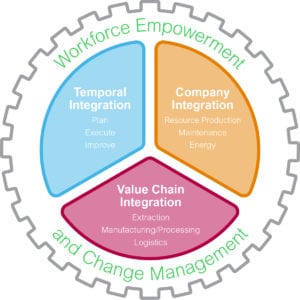According to a McKinsey Digital Manufacturing Global Expert Survey, more than 60 percent of respondents in China, Germany, and the United States are more optimistic about the potential of digitization than they were a year ago. My customer interactions fully support this survey, if not more. However, we recognize that different companies are at different stages of adopting digitization. Many of our customers are looking at how they can jump into the digital transformation in a low risk, cost effective way, yet still ensure they are moving fast enough to keep up with digital’s lightning pace. In addition, they want to know that once they get started there is a path to be able to scale and build the momentum of the transformation, while not being stuck with “one platform” or one vendor. I can confirm, it is possible.
Le Vaudreuil Smart Factory
As more and more manufacturers move forward in their planning and implementation of business-driven digitization initiatives, there are steps you can take to guide you on getting started quickly and easily with digitization to create value for your business without knowing the complete journey yet. These are “no regret” moves for your manufacturing.
On the business planning side, you should first:
- Identify your business pain point or need – as is always the case, the key first step is to identify the primary business pain points that need to be addressed. Then, based on those requirements, it gets easier to identify where to start and which digitized solutions make the most sense.
- Document a roadmap – the steps to be taken on the road to digitization should be documented which then makes it easier to determine what kind of tools, equipment, and software will be needed to achieve future milestones along the journey.
- Embrace openness – it’s important to recognize from the outset that not all situations are new factories built from the ground up. Many are existing facilities that need to have their disparate existing systems from a variety of generations of automation equipment and from various vendors connected and optimized. The importance of openness cannot be understated here. Starting the digitization journey is most often about adding new pieces into your existing framework, so you need an architecture that can accommodate these existing assets and your installed base.
On the technology implementation side, there are three tangible directions companies can take to start or accelerate their digital journey:
- Connect what was not and needs to be connected: it’s about a smart way of connecting what needs to be connected – very often your machines and factories are already connected on-site. Now we scale it up to connect your assets to the cloud (private or public). By doing this you will be able to leverage much more from your installation by drawing more intelligence from cloud-based offers and empowering your people across the company to become business decision makers with easy access. In addition, connected devices open the door to a wealth of data that can improve operational efficiency.
- Modernization: Most industrial companies have existing technologies and assets, whether they are machines, lines or plants. These assets can be digitized by adding some connected products and software on top of what already exists. It means you can get some quick benefits from the IIoT without having to “rip and replace,” while at the same time making your existing investments even more efficient and, therefore, profitable.
For example, in our Le Vaudreuil Smart Factory site, we have implemented a solution on our winding machine where we connected cost effective new temperature sensors and an ITOT box to collect and manage data that our operators then use to ensure the quality of changeovers and predict issues on the machine, resulting in a 7% increase of productivity.
- Leverage data for new digital services: Connected devices open the door to a wealth of additional data and information that can be put to work to use new but existing services that can improve operational efficiency in areas such as asset performance, machine performance, and energy management of buildings, machines, and processes and help customers develop new streams of revenue and business opportunities.
New digitization architectures such as EcoStruxure have been created to link smart machines, edge control, and software apps and analytics so that factory automation can leverage the advanced connectivity inherent to digitization. EcoStruxure is an open yet secure architecture designed for the multi-vendor environments of industrial clients where disparate systems from a variety of generations and vendors are common. The EcoStruxure architecture is designed to easily grow and expand when new pieces are added into this existing multi-vendor framework. Adopting an EcoStruxure architecture can be as easy as deploying an inexpensive augmented reality app that monitors how plant floor equipment is behaving.


